Prelude
"Squeeze tubes," I think. "I'm going to screwed on summit day because of a pair of plastic squeeze tubes." I'll be in Anchorage in 24 hours, on the glacier in just over 48, and instead of being packed and ready to go, I'm standing in the Berkeley REI with a list of success-critical items: plastic squeeze tubes, pee bottle, underwear. Somehow, they're out of stock on the plastic tubes I need to hold gel for summit day. Just an hour ago, surrounded by mountains of packaged meals in Joe's (lessthanjoey) kitchen, I'd given away my entire collection for lunch and dinner condiments. "I'd like them all, but I can probably get by with you keeping one or two." I'd looked at them longingly for a moment, paused, and then replied "nah, I can pick more up at REI."
And so it was with so much of our planning and gear. Despite the months of preparation we'd put in, it was only on the previous weekend that I'd managed to break in my boots in the mountains of South Tahoe; they were already a measure of last resort, and if I developed serious blisters or pressure points the only option left was wearing my Koflachs with overboots and praying for warm weather. I'd also spent the weekend testing a solar panel and 12V camera battery charger, and wound up shorting the charger beyond repair. With a deadline looming, I had another express shipped from Adorama and crossed my fingers that the incident wouldn't repeat. My personal food was still only partially sorted, awaiting an agonizing hour of fine-tuning the final calorie count and dessert-to-energy bar-to-dried fruit ratio. I wasn't even sure if my bags would fit under the 50lb weight limit; for all I knew, I might have to wear my boots onto the plane.
In the end I found squeeze-tube salvation at my local Long's, tucked away in the "camping" isle with bug nets, bungee cords and 2 cu. ft. sleeping bags. Our remaining worries fell out of the last minute scramble more or less intact, though we paid the price in sleep and stress. An early morning in SFO, breakfast in Seattle, next stop Anchorage. It was a rare beautiful day along the southeast Alaska coast, and so long as we could stay awake, the second leg of our flight afforded amazing views of the inside passage's islands and fjords, calving glaciers at the foot of the Chugach, and clear shots at Logan and St Elias.
It was a big relief to see all our bags roll off the conveyor belt at the tackily-named Ted Stevens Anchorage International Airport; you'd think they could at least wait for the guy to retire first. JD (jdmorris) and I left Joe at the terminal with a mountain of gear and caught a taxi to Lowe's. 7 miles roundtrip and a painful $34 in cab fare later, we were back with what was hoped to be our secret sled weapon: 5' PVC poles for sled pulks. Facing a prohibitively expensive cab fare, no food outside security, and plenty of time before our shuttle bus, we ordered pizza delivered to the terminal, snagged some paper towels from the bathroom for napkins, and enjoyed an occasional stray look for the better heeled carry-on-only crowd.
In retrospect, looking at the total cost of the trip, it seems silly that I signed us up for a shared van ride with the Talkeetna Shuttle Service. For a savings of a little over $100 for our group of 3, we were looking at several idle hours in the airport and a full hour motoring around Anchorage picking up other travelers. Thrown onto the end of a long travel day, when all we wanted to do was get to Talkeetna and get ready to fly out, it wasn't worth the cost savings. The driver floored it once out of town, though, and one bumpy van ride and 20 cops writing tickets by the side of the road in Wasilla later, we found ourselves at TAT.
We dropped our bags in one of their makeshift tarp-sided sheds, collected the two boxes of gear I'd mailed up, and hopped in their van for a tour around town. The bunkhouse, the ranger station, the one main street with its collection of restaurants and tourist schwag, the dirt city airstrip with its "no parking on runway" sign, the numerous 10' satellite dishes pointed South at an unnervingly horizontal angle. Small - yes, funky - no doubt; but, a fair sight better than the junkyard wasteland laid forth in Brill's "Desire and Ice".
The plywood-sided bunk area next to the gear shed that we spent the night in, however, lived up to expectations. Peeing distance from the tarmac, the drone of planes was never-ending. After shouting over the background noise while doing some preliminary packing, we grabbed dinner in town and faced our first night of unrelenting daylight.
Day 1: Tue 27th
![Slow n Heavy]() Our gear sits piled at TAT.
Our gear sits piled at TAT.![Talkeetna Airport]() Planes getting fueled and loaded.
Planes getting fueled and loaded.![view on the flight in]() And on the right side of the aircraft . . .
And on the right side of the aircraft . . . ![Landing]() Final approach to KIA.
Final approach to KIA.![landing]() Unloading gear.
Unloading gear.![Hudson Air]() A Hudson Air plane touches down.
A Hudson Air plane touches down.![Kahiltna BC]() Kahiltna BC, w/ Hunter in the background.
Kahiltna BC, w/ Hunter in the background.![Serac fall on Hunter]() One of many serac collapses on Hunter.
One of many serac collapses on Hunter.![Kahiltna 10pm]() 10pm.
10pm.The plan was simple: check in at the ranger station, pack our gear for the plane, land at Kahiltna, practice crevasse rescue and pitch our tent for the night. If I'd known over breakfast at the Talkeetna Roadhouse that 1AM would find me hungry, dehydrated and numb, I might have relished my last hot meal in civilization a bit more. As it was, we were rushed to make the ranger station by 8AM, so we ordered a round of breakfast burritos - fastest item on the menu, according to our waitress - and rushed them down the hatch.
The ranger giving our orientation session was happy to be dealing with climbers who spoke more than rudimentary English and hand gestures, and between his speech and our extensive questions, we were in the station most of the morning. Unseasonable cold had left the mountain in incredible shape; snow conditions were better than anytime in the last 10 or 20 years. "If you're looking to solo Denali" he told us, "this is the year." Using aerial photos, he walked us over each section of the route in detail, explaining where crevasses tended to open up, where the common cache sites were, where people tended to get off-route in storms, and the sundry details we needed to make it back in one piece. We'd done our homework, of course, but it was great to have a top-to-bottom walkthrough with someone who'd been on it.
We returned to the TAT shed to finish packing our gear, got ourselves added to the flight list for the day, and headed back into Talkeetna for cold sandwiches. All told we were at 390 pounds, 15 pounds over the 125lb/person free allowance. The money wasn't a big deal, and we were leaving a tent and some food at the airstrip, but we were also picking up 30 pounds of fuel. How to get it all up the mountain without destroying ourselves, I wasn't quite sure. Short of cutting food, fuel or insulation, there wasn't much room to shave weight off our 140lb/person load.
There was my camera gear, of course. A reasonably heavy Nikon D200, 18-200mm and 12-24mm lenses, 3 batteries, an external battery pack for summit day and a solar panel to charge it all. 10 pounds in total, though I'd forgotten to weigh it before the trip. There was no way I was leaving it at home, and Joe and JD knew better than to ask. In truth, I was lucky to have climbing partners who supported my photographic side forays and were wiling to split the load, but when there was a ribbing to be handed out over the weight of our packs, the camera was always an easy target. So it happened that 10 pounds became 30, and for the rest of the trip, anytime our packs seemed unmanageable, all I heard was how easy our lives would be if we weren't hauling thirty pounds of camera gear up the mountain.
After some time hanging out on the TAT deck watching tourists with rented "glacier boots" look over our mountain of gear, we were ready to fly on Foxy, a 4 seat blue-and-white taildragger. Our sharps - ice axes, crampons, pickets and the like - went on a sled in the belly of the plane, and the pilot started enthusiastically stuffing our packs and duffels in the dead space behind the rear seats. With every bag I became increasingly skeptical everything would fit, yet he was all the more assertive it would; in the end the point was moot, as one of the other pilots scooped up some of our gear and dumped it in the Otter for a later flight.
The inside was deceivingly small, which I'd been led to expect, but nothing prepared me for the absolute lack of forward visibility. The tail of the plane sat lower than the front, and while it looked like a mild incline from the outside, once inside it seemed near vertical; we could have easily gone head-on with a bus and none of us would have seen it coming over the dash. Undeterred, our pilot took one look to the left to ensure the runway was clear, spun the plane onto it in a sharp 90-degree turn, and punched the throttle. There was a moment of true panic as we accelerated towards an invisible horizon, and then we were airborne.
We started out over lush flat forest crisscrossed with rivers, talking with our pilot about his winter job flying sightseers in Hawaii, and transitioned to barren terrain near the outlet of the Ruth and Tokositna glaciers as he identified Denali and Foraker ahead. Almost without warning, the loose rock and dirty glacial snow below gave way to beautiful fluted columns, precariously perched on impossibly steep and fluffy walls of white. As we neared one shot pass, they towered out of sight above and fell away below, seemingly just beyond arm's reach. The pass came and went in an instant, and we found ourselves adrift in a sea of white that stretched in every direction, cracked and broken icefall up high tumbling to the wide flat expanse of the Kahiltna glacier below. We banked right right up the glacier, and as we turned again to make the airstrip I could see rope teams near the base of Heartbreak Hill, small dots in a larger-than-life landscape.
I'd spent plenty of sunny days on glaciers before, but none of them quite prepared me for stepping out of our plane and onto the Kahiltna airstrip. The short transition from Talkeetna's green deciduous forests to the glacier didn't help, but didn't explain the shock I felt either. Glacier travel in the lower 48 typically means being on the convex face of a mountain, with terrain falling away in every direction, but the airstrip was located in a valley of sorts, concave reflective walls of pure Alaskan freshies rising in every direction like the inside of a solar oven. My hat and headscarf were unfortunately among our gear coming on the Otter, so I shielded my head as best I could against the searing solar heat, watched our plane fire up and take off down the glacier, and settled on a sit pad. Welcome to Denali.
During our orientation session, the ranger had told us he wasn't a fan of spending the first night at the airstrip. "If you have your stuff in order, I'd hit the ground and start moving." We didn't have our stuff in order, and needed to practice our crevasse rescue skills as well, but the idea still held promise. We debated and argued, rigged our sleds, practiced our glacier skills, melted snow, cooked dinner, debated and argued some more, and finally agreed to just go for it. It was going to be a late night to 7800' camp.
We started down heartbreak hill at 9PM. The original plan had been to do the whole mountain with only two sleds in the name of glacier safety, but our check-in ranger convinced us that the risk of a first-day crevasse fall was slim and talked us into bringing three. As the guy in the rear, I had a light (30-40lbs) sled and wore my helmet lest it come tumbling after me in a crevasse fall. JD was in the middle with a last-minute rig constructed from 6mm cord, and Joe was in the front with our second pulk. It was my job to keep JD's sled from overrunning him on the downhill, which proved trickier than expected, especially when I couldn't keep my eyes off the mountains around us. The sled would track sideways in a divergent path, and when it finally corrected course there was little stopping it. JD would yell me, I'd either apologize or tell him to man up, depending on how guilty I felt, and several minutes later the whole thing would repeat.
The first several hours went well enough, and we looked to be making good progress. Another hour or two and we'd make camp on one of the harder days of the trip; this Denali thing wasn't so bad. Gradually, I realized my sense of scale was massively distorted; we could see camp at the base of Ski Hill, and it looked tantalizingly close - an hour tops - but it had looked that way for the past hour. My self-assured cockiness waned, and we realized we were in for a long slog. My feet were killing me - the boots were fine, but I'd had tendon issues with them the previous summer, issues I'd thought were long gone until now - and Joe and JD were beat from pulling their heavy sleds. The sun went behind the ridge, and at some point afterwards, things got real cold. I had taken the day as seriously as a five mile stroll in the woods and was short on food; all of us had brought the bulk of our water in camelbaks which were now frozen beyond salvation. With only thin liner gloves protecting them from the elements, my fingers started to go numb. Pump my left hand twenty times, swap ice axe, pump right right hand twenty times, swap ice axe, repeat. Feeling gradually restored itself, but only so long as I kept the routine up.
Even as we all started to deteriorate, we suffered from the tunnel vision of an exhausted traveler. Camp always looked just close enough to keep us plodding one foot in front of the other, just within reach for us to believe we could make it without taking time out to deal with our worsening situation. Rest breaks were short by unspoken mutual consent, to keep our extremities functionally warm. As the cold progressed, JD needed to stop and dig a hat or something out of his pack. "We just stopped. Can't you keep going another fifteen minutes?" I asked, frustration evident with every biting word. "I need to move or I'm going to freeze." In a move that should have come an hour earlier, Joe stepped in with the voice of reason we'd all been lacking. "This is retarded. Lets' just stop for real and take the time to put more clothes on. It's not like things are going to get any warmer." And we did so just in time; dressed in layers that ought to leave a fresh body sweating at rest, I never got beyond lukewarm during the rest of the night.
Joe and JD had been slogging well below my natural pace for a while, and with only half an hour to go, JD gave up on the sled. His legs were destroyed, and he'd sooner make camp here than carry it any further. All eyes were on me, with my wimpy sled, but there was no way I could take it on. By this point my feet were in tremendous pain, and the only way I was able to stay on them was by moving faster and building up slack in the rope, then briefly stopping and resting on my axe; there's no way I could keep that routine up with a heavier load. Faced with the option of making camp or pressing on, we ditched the sled by the side of the trail and kept going. Finally, at 3AM, we hit 7800'.
Unable to find an available tent site, we cleared some soft snow off a flat spot next to the trail and collapsed. Destroyed by the sled, JD was having trouble staying warm, so we got the tent erected quickly and got him inside. Joe and I tried to get the rest of our gear squared away and collected in one place, and I wandered over to the wanded waste hole to pee for the first time in hours. This being our first night on the mountain, we hadn't yet figured out that we didn't need to pee in the CMC disposal hole; indeed, getting close enough to the edge to actually hit the void was probably more dangerous than any climbing we'd see.
Nonetheless, I gave it my best shot - as, evidently, had countless others - and discovered that the crevasse the NPS had unearthed ran straight towards our tent. All three of our avy probes were back down the mountain on JD's sled, so we were unable to probe the site. There was no visible depression marking the snowbridge, but as horrible thoughts filled my mind I knew I couldn't relax until the situation was resolved. Joe and I tried our best to probe the area around the tent with 4' bamboo wands, and I dug a pair of deep holes to check snow conditions, but even then I didn't have the peace of mind I would have liked. Apologizing under my breath, we woke JD up, had him crawl out of his bag, moved the tent, climbed back inside, and collapsed.
[JD] How could a trip this long start off with a day as bad as this? I'm typically colder than Joe and Matt so I wore more clothes and kept warm clothing accessible from the start; when they complained of freezing, I was comfortable. On the other hand, I eat around twice as much as the rest of the team and while my planned three hours of food stretched longer than I had intended since we rarely slowed down to eat, I ran out of food with several hours to go and my caloric intake plummeted. Trudging down Heartbreak Hill had been easy enough and the sled and pulk seemed to be working well, but when we turned uphill I rapidly discovered that pulling a 100lb. sled is not just difficult but downright painful with every step. When I finally abandoned my sled after many hours, I started thinking that I might be done for the whole trip. My hip abductors were completely non-functional after carrying and pulling more than my own bodyweight, to the point where just walking with my comfortable 60lb. pack was now very challenging. When we finally got to 7800' camp, I put on my warmest clothes and climbed into my -40 degree bag, where I shivered uncontrollably. I was so weak, faint and disoriented at that point that I'm not sure I ate or drank anything. However, despite shaking like a leaf while wearing more clothes than I realized would even fit into my bag, I fell asleep fairly quickly. Camp moved a couple times and Matt and Joe went about regular business but I slept for an amazingly long time, only occasionally waking to wonder what I was going to do with my screwed up legs and how I was going to recover from that bad of a bonk. Welcome to Denali!
![Kahiltna at Midnight]() Midnight on the Kahiltna glacier.
Midnight on the Kahiltna glacier.Day 2: Wed 28th
![7800 camp on Denali.]() Our gear haphazardly scattered around camp as we left it the night before.
Our gear haphazardly scattered around camp as we left it the night before.![7800 camp]() Camp at 7800'.
Camp at 7800'.![Hi Birdie]() JD grabs a bird mid-flight.
JD grabs a bird mid-flight.![And ye shall call it the valley of death.]() Serac fall above the NE Kahiltna.
Serac fall above the NE Kahiltna.As I lay in my bag, staring up at the impossibly bright yellow walls of the tent, I felt like the morning-after-a-disaster protagonist in a Hollywood flick. The kind where, in the heat of a battle or the worst of a storm, the scene fades to black and slowly dawns on the destruction left in its wake. Our hero, passed out on the ground and half-buried in debris, slowly wakes to the warm sunshine of a fairytale day. Too stiff to move, he looks around, trying to piece the previous night's events together into a story that explains his present situation. He squeezes one hand, then the other, and slowly begins to regain motor function from the extremities in. Eventually, still puzzling over exactly what happened, he manages to struggle to his feet and stumble through the wreckage. In some ways, it was a lot like waking up after a night of heavy drinking, except I knew the names of the people sleeping next to me.
Outside the tent, I surveyed our situation. There were a few people moving about camp and some groups stretchd out along Motorcycle Hill. The brightness inside our tent was just an illusion; outside, converging clouds were rapidly closing the last window of blue sky. Water, I thought, I need water. Our camelbaks should be unfrozen. I hobbled over to my pack, took a long, beautiful draft of the stuff, and then I saw it: bird shit. And not just my pack; it was all over Joe's and JD's, and our duffels. A minute of panic and a quick check confirmed that, even though we'd left zippers open, they hadn't broken into our food supply.
As it started to snow, I realized we hadn't left any wands to mark the sled. A foot - possibly less - and we could give up on ever seeing it again. I decided to wake Joe up. "There are birds shitting all over our packs, it's snowing, and we need to get the sled before we lose it." It was a friendly way to kick off our first rest day. By the time Joe dressed and geared up, the snow had started to lift and a primo tent site was opening up nearby; we decided to move camp first and get the sled later.
Relatively fresh and without a heavy pack, the pull back to camp with JD's sled went well. We used a tarp to construct a nice covered porch for our tent, broke out the iPod and a pair of speakers, ate lunch, and got to work repacking everything for our carry the next day. As I sat on a foam pad in the cool blue shade sorting my food for the cache, small birds flitted around camp, occasionally joining me for a noisy pass through our shelter. They weren't particularly fast, and with a little focused effort JD managed to snag one with his bare hand, holding it prisoner for several minutes before setting it free. How they survived the journey here - and where they went at night - I knew not, for they were mere songbirds, remarkably smaller than the ravens of 14k. Clearly they lived the most marginal of existences, as a small handful were scattered dead on the glacier near camp or the trail.
At some point a soloist attempting a new airstrip-summit-airstrip speed record cruised through camp, the swishing of his skinny cross-county skis lasting only an instant before the air was again silent. As I watched in the still afternoon heat, his rapid progress up Ski Hill belied its true size. With tents scattered for several hundred yards along the trail, camp was quiet save the occasional buzz of a bush plane flying high over Kahiltna Pass or serac fall echoing from the NE fork; Valley of Death indeed. Despite the lazy pace, I doubt I spent more than half an hour actually idle. I had no idea at the time, but that was actually pretty good as far rest days would go.
![View from 7800]() Looking up the NE Fork Kahiltna towards Denali from 7800' camp.
Looking up the NE Fork Kahiltna towards Denali from 7800' camp.Day 3 : Thu 29th
![ski hill]() View up Ski Hill.
View up Ski Hill.
We woke up at 9, finally left camp at around 11:15 and didn't get back until 7:40 that night. Looking at mileage and elevation changes for the mountain, we'd planned on carry days taking around 5 hours, which now appeared grossly off track. We were all a little short on food as a result, but at least the trip back down went quickly. For reasons unknown, Joe's GPS altimeter seemed to be consistently reading 200' low.
Switching roles from our first day, I got the front of the rope team with the heaviest sled, and JD took the rear with a light load. Even with the switch up, the toll of our first day's travels wore heavy, and a desire to get off my aching feet only increased the gap between our speeds. As the day wore on and we drifted further from our target schedule, frustration over our pace mismatch grew; I found myself cursing my teammates' exhaustion under my breath, and it seemed we could barely make progress before one of them would again call "down!" as I unknowingly hurried the pace. My feet ached more and more, and as I began to wonder if I'd even make it to 14k camp, JD declared that he needed a break.
"Already? We just stopped." It was shitty thing to say, and although I regretted my testiness, I was simultaneously unable to control it. My feet were in almost unbearable pain, and I knew from experience that the worse they got today, the worse they'd be tomorrow. They seemed to hurt in proportion to weight born and time spent on them, so taking on more weight to bring our speeds in sync would do nothing for me. My only hope was to drop our load and get back to camp quickly.
There was another factor at play, too, one which was only beginning to form. On previous mountaineering trips with Joe and JD, I'd developed a history of dodging disasters that befell the two of them, only to never hear the end of it later. Years ago, unaware of the severity of Sierra 4th class, we'd had plans to climb several 14ers in the eastern Sierra. I bailed at the last minute to spend time with a friend who was flying into town, while they got stuck soloing very loose and equally dangerous 5th class terrain. On a trip to Ecuador just six months prior, less than 24 hours after arriving in country, we'd intentionally separated on an acclimatization hike outside of town. They'd wound up kidnapped by a masked man with a gun and machete; I was the only hiker on the summit that day who walked away unscathed.
Both experiences ranked among their most traumatic in the outdoors, and I'd been scheduled for both, only to miss out by pure luck. Even now, sometimes, when discussing a difficult lead or minor epic, I'll hear how it's "nothing compared to Middle Pal. You're so lucky you weren't there." Similarly, if I were to roll my car off a cliff, I'm sure I'd come back to a yawn and a discussion of how at least I wasn't marched downhill at gunpoint by a crazy guy I can barely communicate with. Although clearly in a different league, I was starting to get the sense that the heavy sled pull on our first day was another experience of shared suffering that I'd missed out on, yet which would come to define the standard of sacrifice for the remainder of the trip. The retort to my complaints over pace was already "Dude, you had a light sled the first day." It wouldn't take much for that to become the de facto response to any problems I developed.
We pushed onward to around 10,500' and dropped our gear. Food, loose clothing, stuff sacks and zip lock bags galore made their way into a trio of 3mm trash bags. We dropped them in the hole, repacked snow on top, stuck a cache marker on an avy probe, and left it standing as far out of the snow as we dared. We'd been told that a combination of wind and avalanches left the final ascent gully with a disproportionate snowfall during storms; one season had dropped nine feet and buried every cache in the area.
![NE Kahiltna]() Looking down from Ski Hill into the NE Fork Kahiltna.
Looking down from Ski Hill into the NE Fork Kahiltna.Day 4: Fri 30th
![Kahiltna tested, Kahilta approved]() Modeling the latest fashions in functional sun-protection glacierwear.
Modeling the latest fashions in functional sun-protection glacierwear.![top of ski hill]() Joe at the top of Ski Hill.
Joe at the top of Ski Hill.![11k camp]() Joe checks out Foraker during last light at 11k.
Joe checks out Foraker during last light at 11k.
We'd cached everything we didn't need for the next two or three days, and in theory, that meant our load on move day should be little more than a 3 day trip up Rainier, but with sleds as an added bonus. 30 pound pack, 30 pound sled, no problem. If that was the case, I sure didn't feel it. Ski hill was still a long, slow slog, more so for the fact that I knew how deceivingly close the top looked. Same for the endless flats beyond; yesterday, with rapid cloud movement frequently obscuring the route, I'd been able to delude myself into thinking that the final right turn below Kahiltna Pass was always just around the corner. Today, roasting under a brilliantly clear sky, there was no denying reality.
We made camp late, and our priority was shelter, water, food and sleep. Denali has close to 24 hours of daylight, but the southern aspects see plenty of shade and the resulting temperature swing is severe; beyond the real temperature difference, solar warming has an almost incomprehensible effect on perceived temperature. When the sun sinks, things can go from lawn-chair-and-a-bbq warm to toothbrush-freezing-while-you-use-it cold in just a handful of minutes.
11k is the first of what you might call the official camps on Denali. Below, tents are strung out all over the mountain as campsites abound and parties stop whenever they get the urge. From here on, terrain limits reasonable site choices to the standard 11, 14, and 17k locations, and the resulting alpine sprawl mimics the organic growth of a small town. A transient rest stop between the lower reaches of the mountain and advanced base camp at 14k, the site's focal point was clearly the trail up the mountain. It ran the length of camp like a giant main street, with massive snow walls fencing in tents on either side. Occasional side streets led off to bathrooms, cook areas, and small tent clusters set back from the main path; skis, sleds and wands marked caches throughout. As new inhabitants arrived and built out on fresh snow at the top of camp, the lower sites melted out and filled up with caches, urine and dishwater, eventually devolving to abandoned, condemned slums of unstable structures and depleted ground. Never wasteful, as camp slowly moved uphill, enterprising climbers would use their sleds to quarry blocks from collapsed sites.
We found an abandoned snow wall that would fit our tent with minimal effort, and set about leveling the floor, melting snow, unpacking our tent, inflating our sleeping mats, making dinner, changing into warmer clothes, getting our gear secured against overnight snow or high winds and all the other fun stuff that comes with camp in the backcountry. By the time we were done with dinner, it was cold enough that rinsewater was freezing to our bowls before we could dry them off. It was time to get out of the elements and get some sleep.
![Foraker from 11k]() Foraker from 11k.
Foraker from 11k.Day 5: Sat 31st
![Shoveling out the cache.]() Joe and JD shovel out the cache. Normally, my camera just means carting extra weight around. This time, it gave me an excuse to slack while they dug.
Joe and JD shovel out the cache. Normally, my camera just means carting extra weight around. This time, it gave me an excuse to slack while they dug.
There wasn't any danger of a serious storm blowing in, but the mountain was enveloped in fast moving cloud. The white stuff would billow over the ridge to the south of camp, or rise up the eastern valley climbers follow, wipe out visibility, and then rapidly rise, fall, or blow away. There was no risk of disorientation as the route down to our cache was well wanded and packed into a highway, but it did make temperature regulation difficult. Freeze in the clouds, roast in the sun, or constantly stop and change.
We made good time down to the cache and dug it up without a lot of effort. Following the lead of a guided group next to us, we'd marked our cache with small wands in the corners in addition to a big avy probe with a cache tag in the center, and this proved a real nice trick. I thought I'd be able to keep track of where the cache boundaries were relative to the avy probe, but returning two days later I realized how foolish that was. As I'd later discover on return to the airstrip, it really sucks to dig down 2-3 feet only to find you're on the wrong side of the wand.
Two thirds of the way back up to camp, JD gave up in frustration and leaned on his ice axe. "I just can't do it any more. Do you mind if we leave my sled here and I'll come back down solo with an empty pack and pick it up? My legs are dead." Unroped glacier travel on the conditions we faced didn't concern me too much, but I was doing too well to let JD make the second roundtrip. "How about we piggy back your sled onto mine and I'll take both of them into camp?" I couldn't have gone very far, but the load looked doable for the last several hundred feet.
Back at camp, though, we had some strategizing to do. There was no way JD was making it to 14k tomorrow, not if he wanted to stay strong enough to go higher than that. It was our bad for loading up two sleds the first day and going light on the third, and he was paying for it. Joe had experimented with clipping his sled through his harness leg loops, and the resultant pressure left the surface his left thigh numb, worrying us all. There was no point in pushing to the point of breakdown, but I was concerned about our pace. We weren't leaving much at 11k, and the carry to 14 would be just as bad, if not worse. Would that mean yet another lost day resting at 14 before pushing higher? We had the time in our schedule, but it was supposed to be for weather up high, not us being wimps down low.
After a little back and forth, we hit on a plan to break the trip to 14k into three days. It wouldn't save us any time v. taking a rest day, but because we'd have lighter loads, we hoped to spare our legs. Joe and I would go tomorrow, then him with JD the next day, and we'd all move on number three; in exchange for going all 3 days, Joe would get a lighter load.
![changing weather]() A group of skiers heads up the final leg to 11k camp under fast-moving clouds.
A group of skiers heads up the final leg to 11k camp under fast-moving clouds.Day 6: Sun 1st
![clouds over 11k]() Clouds envelop the ridgelines near 11k camp.
Clouds envelop the ridgelines near 11k camp.![Joe on Squirrel Hill.]() Joe waiting at the base of Squirrel Hill.
Joe waiting at the base of Squirrel Hill.For the conditions we encountered up until 11k, solo glacier travel seemed about as safe as it can get. No open crevasses, no punch-throughs, a few lightly depressed snow bridges, but none that looked dangerous. When Joe and I roped up and left camp, we rapidly discovered that 11k on is a different story. Barely up Motorcycle Hill, we passed our first punch-through of the trip: a foot-shaped hole through about 8" of snow, with nothing underneath. This particular crack was too small to eat a person, but there were many more between here and 14k, and I welcomed the comfort of our skinny 8mm tether.
It is critically important to have your stuff in order before getting on Motorcycle Hill. While not steep from a climbing perspective, it's at just the right angle to make your sled a massive liability. The hill isn't steep enough to front-point, but if you have a pulk, you can forget about turning your hips sideways; your only option is to duckwalk straight up. Even then, you'll feel like something is trying to pull you over backwards, and you've got no hope of getting the sled to sit in place so you can take the weight off. Similarly, you can give up on trying to take your pack off: whatever you're wearing at the base, you're stuck with it till the top.
One poor girl was stuck in place above us on the hill, part of her group already topped out and part far below. An arm on her pulk had come loose, and leaving the sled fully supported by the other. The loose arm had burrowed into the snow, halting her progress, but the good one prevented her from turning around to deal with the situation herself. The pulk was constructed from nested tubing, with little buttons on the inner tube that pop through holes on the outer tube to set the length. Snow and ice was preventing the buttons from expanding and locking the tubes together; I looked down at the train of climbers below with a sense of horror at what might happen if the second pole popped free.
Squirrel hill ahead of us was one massive cluster. Climbers were bunched up on the uphill, rope teams trying to pass other rope teams, skiers laying track off to the right, soloists descending with poorly controlled sleds on the left, all with a massive runout potential. The only reasonable path was a tiny sliver of snow packed down from early season storms which snaked its way through a field of blue, bulletproof ice. Joe kept bugging me to see if I could pass the backlog, but the team in front of us was already trying to pass the team in front of it without success, and I didn't see how adding a third rope to the mix could help.
Teams fell out as we cleared the top of the hill, and we were more or less alone by the time we made our final tracks to Windy Corner; with a light load and Joe behind to help control the sled, the side hill afterwards went smoothly. There were open crevasses here, capable of swallowing a misplaced sled or careless climber; indeed, several of them were directly in line with the cache site beyond. It was enough to make me wonder, when you see large unroped groups unearthing caches, whether it's a sign of collective wisdom passed down by those who know the mountain well, or the lemming-like perceived safety of group stupidity.
The road from the cache site to 14k is well marked, gradually sloped, and deceptively longer than it looks. It's also right at the focal point of a large concave slope, a natural solar oven. The sun had broken out from the clouds, and as we headed uphill, I started to get hotter and hotter; the world seemed brighter and brighter as the sun's intensity grew. I started to fade, began zig-zagging back and forth up the hill, and finally couldn't take it anymore. I collapsed to my knees, ripped my hat off, scooped up two big handfuls of snow, and plastered them onto my forehead and the back of my neck.
It took about five minutes under a snow shower before I was able to move on. 14k was enveloped in a fog-like layer of cloud, and we dug our cache site, wandered around camp briefly, and bailed back to the lower reaches of the mountain. Just above the standard cache site, we passed the elderly Asian group that had been at the head of the backlog on Squirrel Hill, still working their way up the mountain. Stripped to hiking pants and a white shirt and still hot, I looked at them in amazement: every one as covered head-to-toe in Gore-Tex, with hoods up, goggles on and a few with neoprene face masks. As they shuffled ever so slowly up the mountain, one foot at a time into the sweltering heat, I gave silent thanks that I was too young to climb when one piece Gore-Tex bodysuits ruled the land.
![squirrel hill cluster]() Backup on Squirrel Hill.
Backup on Squirrel Hill.Day 7: Mon 2nd
[JD] This was the first day of the trip that I finally felt good and started seeing the trip in a positive light. While visibility was low all day and I rarely saw much beyond a couple hundred meters ahead, the climb up Squirrel Hill was easy and there were very few other people around. The stories Joe and Matt had regaled of blue ice and a tedious climb up the hill all seemed overblown given the ease with which we made it up and down. The day was also a breakthrough as Joe and I distributed our loads markedly differently - I had a very heavy pack and a super light sled while Joe had a super light pack and a heavy sled. The plan worked for both of us and we both had fewer problems with pace, fatigue, warmth or anything else than ever before on the trip. I hoped that it all would continue. It was great to get out and haul for a day without crawling into the tent at the end of the day feeling like I'd been beaten into submission. Back at camp all of our spirits were high.
It was nice to have some free time around camp while Joe and JD made their carry. My only real responsibility was melting snow, hardly a challenging task, and I had the opportunity to sleep in, top off my camera batteries, read and listen to music. In the middle of the day, four crazy skiers started making their way up the icefall to the right of Motorcycle Hill; Assuming they were on a day trip looking for turns, I grabbed my camera and sat in wait. The lighting on the snow as producing good shadows, and if they dropped in at the right spot, I'd surely have a shot worthy of a page in Couloir or some other ski rag [Note: This year's BD winter catalog included a picture of the very same scene I was hoping to grab, with similar lighting]. I spent an hour standing around in the sun, tracking them, camera at the ready, constantly checking and rechecking the settings: continuous high shutter mode, matrix metering, correct ev comp, continuous-mode AF, etc. At one point two of them stood atop an ice block on the upper reaches of the hill, poking around with their poles as if checking a cornice. I stood, waiting, a patient hunter. They turned, switchbacked in the other direction, and headed over the ridge towards the base of windy hill - an interesting variation on the tourist route.
![Skiers above 11k]() I was really hoping they'd drop in somewhere around here.
I was really hoping they'd drop in somewhere around here.Day 8: Tue 3rd
[JD] The day started out in a threatening whiteout but we had all seen most of the route ahead and were confident that we would have minimal issues with route finding. We cached snowshoes and a small handful of other things near our tent site, and with two caches already placed up the hill we were primed for a good day. For me, it was the second day of carrying a very heavy pack - now with no sled - and I was quite happy with the change. Through the crevassed areas near windy corner we struggled a bit with the sled we did have but otherwise things went smoothly. On the way up the final climb to 14k camp, there was a distinct change, however. Matt's problems with his feet, although expressed modestly rarely, were well ingrained in our minds. My complaints about my legs had become so commonplace in the earlier days that they had likely lost their meaning. And until now, Joe had been smooth and steady. However, after taking over our heavy sled for the final approach to 14k camp, he complained of increasingly significant pain from his legs, until when we finally stopped at camp, he stated bluntly, "my legs are completely fucked." He was confident his trip was ending there at camp and he would go no further up the mountain.
Although Matt and Joe had seen 14k camp on a previous cache day, in the very dense whiteout in which we'd arrived it seemed like an endless labyrinth of full tent sites with almost nowhere for us to setup camp. After much wandering and surveying we determined that there were only two available, preexisting walled structures in all of camp and they were both fairly undesirable with garbage strewn about and uneven floors of ice. We eventually settled on one site and got to work with building what would be our 'home, sweet home' for days to come and by the time we settled into our bags it was just as long and epic of a day as those that had preceded it.
The move to 14k was an impossibly long day. The route had little to offer the 2nd or 3rd time around except slower progress under heavier loads. Motorcycle Hill was still a few steps short of impossible with a sled; I again found myself stumbling over the top overheated and dehydrated. Squirrel Hill was backed up, though not as bad as before. Windy Corner was windy, stripping our warmth as we approached despite the heavy exertion. The traverse that followed required slow movement and careful coordination to keep the sled on track, and before long we were once again roasting on the final approach to 14k; just like before, camp itself was shrouded in clouds. As we dropped our packs and stumbled through the haphazardly-planned boulevards and back alleys of camp, I found myself again blown away by the mountain's weather fluctuations.
![Sorting gear in a whiteout.]() Preparing our ropes in the clouds before leaving 11k.
Preparing our ropes in the clouds before leaving 11k.Day 9: Wed 4th
![Approaching 14k]() Climbers on the final approach to 14k.
Climbers on the final approach to 14k.![Lama]() The Lama in flight.
The Lama in flight.It was JD's and my turn to get the cache at the base of windy hill. A quick trip down, a few hours in the sun on the way back, and we'd finally be settled at the 14k home-away-from-home. We only had to take what we needed to 17k; the spare week's supply of food in the duffel, sorted into so many zip-lock bags and vacuum-seal pouches, the extra gallon cans of fuel, the solar panel and associated chargers, my wide-angle lens, a batch of once pure-white long underwear stained brown with dirt and sweat, stiff socks, torn liner gloves, sleds, tarps, duffels and rigging, banana chips and dark chocolate whose taste had gone with altitude, the 20 oz gatorade bottle full of rum we'd yet to crack, extra TP, sanitizer, alcohol wipes, tiny iPod speakers, excess wands, garbage, the snowshoes I should have left at 11k, all could be safely buried under the snow and left behind when it came time to move on. Sure would be a nice feeling to get the trek to 14k out of the way.
We slept in, melted snow, improved the shelter and grabbed lunch before heading out at noon under sunny skies. We hit the cache in 45 minutes and took the better part of an hour digging it up, repacking, and collapsing the site. The wind had been rising and temperatures falling since we rounded Windy Corner, and our Camelbaks were freezing. A light cloud layer enveloped us - the weather on the mountain can change *fast* - and we rushed to throw on extra layers. It appeared that, for once, I might not fry on the final ascent to 14k.
The sled was heavier than I'd hoped but still light for a Denali carry day, and we made good time back to 14k. Joe and I dug up our cache on the edge of camp - once again, I'd made the mistake of not marking the cache boundaries with wands, and dug out the wrong side of our cache marker. Everything takes longer on Denali, and by the time I'd explored camp, paid a visit to our local neighborhood pit toilet, guyed out the tent properly and snapped a few photos, it was dinner time. Back in Anchorage I'm sure only the old folks were thinking about food, but on the mountain, happiness was being in the tent when shade crept over camp.
Dinner was couscous with mushrooms; we'd forgotten seasoning for the couscous, and the mushrooms rehydrated to resemble the taste and consistency of cardboard. I sat in the entranceway of the tent, feet out in the vestibule, and tried to force it on myself as I gazed at the ground and slowly rocked back and forth. I stared, poked and stirred at my bowl, occasionally bringing myself to down a quarter fork full. Outside, Joe and JD were having a lively conversation about something, but their words were just dull chatter beyond my world of single-minded concentration. Finally, my stomach did a backflip and I could stand it no more. I shoved my bowl through the fly and with a pained voice said "I'm done. I can't stand anymore." I kicked my boots off, crawled into the tent, curled up in my bag, and lay there facing the tent wall in a giant ball of misery.
![lama rescue]() Rangers load an injured climber into the Lama after hauling him up from the N side of the Buttress and bringing him down to 14k.
Rangers load an injured climber into the Lama after hauling him up from the N side of the Buttress and bringing him down to 14k.Day 10: Thu 5th
There was no doubt about it, I was definitely sick. It wasn't the altitude: I could breathe fine, lacked a headache, wasn't nauseous or dizzy. But my appetite was gone and a weak, achy exhaustion ran through my bones. I froze while others were hanging out in thin shirts, yet when I stumbled over to the neighborhood pee hole, the short walk was enough to give me the sweats. I was fucked, and very lucky that it was a rest day.
![Home Sweet Home]() Home sweet home.
Home sweet home.Day 11: Fri 6th
![14k camp]() Layout of 14k.
Layout of 14k.![Hunter from 14k.]() View of Hunter.
View of Hunter.Day 12: Sat 7th
[JD] Under a cloudless sky and with full stomachs Joe and I attempted our cache day, again. There was no slowing down on the way to the fixed lines and morale was high. While at first we were making good axe and foot placements on the ice of the fixed lines, this proved slow and tiring. In previous conversations Matt had always said not to weight the fixed lines, so I merely dragged my ascender up off tension as an aid only in case of emergencies. However, large groups were descending the lines and while their brief, passing stories kept us entertained and motivated during the ascent, the fact that they all hung almost entirely off the fixed lines at most points in time made me rethink my strategy; some descending guides I queried responded that a fine technique would be just to jug the fixed line up the ice. With that lesson learned we went back to making quick time up the headwall. I responded to another guide who asked how we were doing with something along the lines of, "great, now that we're actually doing something fun instead of just slogging around." His brief response of "If you think this is fun you're going to have a great time on the ridge" boosted our motivation yet higher, and so we eagerly pushed on.
The ridge was fantastic, mildly exposed, and occasionally even a bit challenging with our packs on. The monotonous route was now getting exciting and Joe and I were firing on all cylinders. However, the cruel Denali weather rapidly changed everything, as it so often does. What started off as a cold breeze at the top of the headwall gradually transformed into sustained, driving gusts and a whiteout; we had no idea how much further there was to go to 17k camp. After a party descending above Washburn's thumb told us that it was several hours to anywhere we could cache and further yet to camp, we began searching for somewhere to leave our cache. Everywhere the snow flattened out for even a few feet was solid ice. There had been a few large rocks one could use for shelter just below Washburn's thumb, so we started back down the way we had come, still with our heavy cache loads on our backs, looking for anything that would make do. Finally, and before we had lost too much elevation, we found a huge rock to dig underneath and stuffed our cache as far into the slot of ice and rock as we could. With the weather swirling around us and the precarious location it seemed like wind or birds were likely to move the cache before we'd ever get back to it, and in the following days I worried that we'd never see it again. However, we were wearing all the layers we had and were still starting to get cold from not climbing, so it was time to stop thinking and start moving. Just a couple hours later we were back at 14k camp on a calm day gazing up at the wind and snow blowing over the top of the Buttress.
I was still sick, with no signs of improvement. With 12 hours a day spent in a single-wall tent, it wasn't clear how Joe and JD were going to dodge the bullet on this one. I'm not happy at missing out on a key piece of acclimatization, but the extra days we plan to spend in "medical camp" - as the foreigners call 14k - should buy me slack if and when the time comes to move. If it doesn't, my partners plan on commandeering an igloo and stashing me there until their return.
I felt well enough to make a short walk around camp and take in the sights. Lacking a main thoroughfare, the place resembled the downtown heart of an old city, mazes of snow shelters grouped like neighborhoods around crooked roads. The south end of town was inhabited by the NPS: their few large and brightly colored communal tents, solar panels, and bulletin board up the hill from the residential zone, standard mountaineering tents tucked back behind snow walls so tall that they barely peeked over the top.
To the West was the old town, a haphazard collection of snow shelters worn with age, some deserted and half-cannibalized, others sporting a patchwork of improvements from their many transient residents: a cabinet constructed from sleds, an entranceway with a 90-degree bend to block the draft, the occasional abutting igloo, wall art and snow sculptures. Things had no doubt been built and rebuilt so much over the season that I wondered if any sign of the original structures remained.
Guided groups, on the other hand, represented the grid-like order and rapid growth of the modern American suburb. Seeking space, they passed through to the east side, where an endless backyard of fresh, flat snow sprouted multi-tent McMansions along streets so wide you could land a helicopter. It was nothing short of amazing to watch the process in action, as they shoveled snow and quarried blocks with a speed and efficiency that would have made the Roman army jealous. Like the prefab construction of their urban parallel, the delta between camps was cosmetic at most: a different colored cook tent, or MH Trangos instead of TNF VEs. Beyond that they were all the same: A cone-shaped collapsible cook tent with sunken trench-like floors, a row of burly 4-season tents inside a single snow wall, and just beyond earshot from the rest, a red or green Hilleberg for the guides, flexible solar panel lashed to the sides.
I set my camera up to take some time-lapse footage from a boulder just beyond camp, melted snow, setup the solar charger, and tried to enjoy the day.
![Lama and Foraka]() The Lama is framed by Foraker's slopes on the way in to 14k.
The Lama is framed by Foraker's slopes on the way in to 14k.Day 13: Sun 8th
![edge of the world]() Joe and JD take a seat at the edge of the world.
Joe and JD take a seat at the edge of the world.
Holy hell, when will it end? I'm so sick of being sick. We took advantage of a weather window to make the trip to the edge of the world today, the must-see spot where the glacial plateau supporting 14k camp meets the mountainside and drops precipitously towards the NE Fork Kahiltna. I made it, over and back, but there's a world of difference between that sort of schlep and the journey to 17k.
Seems all I do is lie in the damn tent; sleep and read, read and sleep. Bibler/BD claim that a bright yellow tent helps keep the cheer on stormbound days; this may be, but after a while your eyes simply adjust to the filtered light. Your yellow pee? Visually indistinguishable from water. Those yellow underarm sweat stains on your white shirt? Invisible. Everything else? Looks just like it did before. Yeah, it's real cheery in here.
My long tentbound sessions are broken only by occasional dashes to the local urine pit to empty my pee bottle and bladder. It's a sight that probably inspires humor in others, though I can't say I feel the same way: a figure, clad in white long underwear top to bottom, half-laced camp booties on his feet, 1.5L Nalgene in hand, stumbling and squinting against the midday glare as his neighbors rope up for the trip out of camp.
![edge of the world to hunter]() Looking across to Mt Hunter from the edge of the world.
Looking across to Mt Hunter from the edge of the world.Dat 15: Tue 10th
![bergschrund]() JD at the 'schrund on the fixed lines.
JD at the 'schrund on the fixed lines.![Above the fixed lines]() Initial ascent above the 16,200' saddle.
Initial ascent above the 16,200' saddle.![Higher on the ridge]() Joe on the ridge.
Joe on the ridge.![The Thumb]() Joe comes around the Thumb.
Joe comes around the Thumb.![Clearing Weather]() Another party catches as the weather clears close to 17k.
Another party catches as the weather clears close to 17k.![Almost to 17k]() JD on the final section of ridgeline.
JD on the final section of ridgeline.Today's the day. I felt ready yesterday, but the more time we leave for recovery, the smaller the chance of a relapse up high. The cache is already dug, the snow melted, the ropes laid out and gear sorted. All we have to do is pack up the tent, throw a few last minute items in the cache and head out. Still, it's taking forever. It doesn't help that our cache day was light-loaded with my absence; out of room in our cavernous packs, we've strapped whatever we can to the outside: tent, CMC, the toilet seat I still find humorous, sleeping pads, nalgenes, pee bottles, jackets, wands, shovels, snow saw, pickets, helmet. Combined with the crevasse and fixed line gear on my harness, a custom shoulder pouch stuffed with food and sunscreen, camera bag and bulging pockets, I feel like the unorganized version of a hobo's shopping cart.
Somehow we managed to grossly miscalculate our water supply, the source of a heated discussion pitting me, the team's heavy drinker, against my teammates. The day is dragging on and I'm as motivated to leave camp as they are, but the 45 minutes it would cost us to unpack the stove and melt snow seems like a false economy if we crash and burn halfway to 17k. In the end I manage to bitch my way to an extra ration, and compromise in hand, we set out.
We made good time to the base of the fixed lines, where gradually dropping temperatures forced us to stop and layer up. Joe and JD had learned the hard way that it's a long trip to the top of the lines; weather can change dramatically, and unshouldering your pack to pull out a jacket just isn't going to happen. Even here, below the lines, the terrain was steep enough that I had trouble getting my pack on without flipping over backwards. We waited for another group, and then JD clipped in and we were off.
There's a lot of things we could have done differently on the trip, and the fixed lines rank high on that list. Spaced out the full length between our tie-in points, just like on the rest of the mountain, we were forced to stop whenever one of us hit an anchor point on the line. I couldn't manipulate my ascender well enough with my gloves on, so every anchor point required me to plant my axe and remove them. Sometimes the knots at the anchor occupied enough space that I could barely get my safety biner on the next line before removing my ascender from the last. The snow was impenetrable, and my feet began to ache from sitting at a 45 degree angle. It seemed I couldn't make it 30 feet without hearing a call of "Anchor!" echoing along the line, forcing me to rest awkwardly and impatiently await a call of "Clear!". Sometimes Joe below me would barely clear an anchor before JD or I reached another, causing our train to lurch several feet and grind to a halt again. I cursed my teammates' fumblings as they cursed mine.
Joe had dislodged his pee bottle near the base of the lines and been forced to watch it tumble back to 14k at alarming speed; with all the crap tied to my pack, I didn't trust myself to get a drink without dropping a Nalgene missile on climbers below. The start-stop rhythm of the lines destroyed our normally excellent rest break discipline, and by the time we stumbled out onto the saddle at the top of the lines, we found ourselves in bitingly cold and windy weather, exhausted, with two hours of heavy exertion between us and our last food or water.
We found shelter behind a rock just up the trail, threw on layers, and gobbled energy gel, gorp and clif bars. Half-frozen Nalgenes were banged against rocks to break up the ice and free our dwindling and clearly inadequate water supply. Somewhere on the lines the weather had blown in - I hadn't even noticed - and the sky and horizon were now lost in a sea of white. I was miserable, and I could tell Joe and JD were too: seriously chilled, dehydrated, bonked. But there was no turning back.
We moved past several useless anchor points, through a tricky and hard to protect section using body belays, and up onto the ridgeline proper. A pair of Spanish climbers were tucked back in the pocket where JD and Joe had left the cache, wrapped in a space blanket, making hot drinks on a jetboil and smoking cigarillos. Washburn's Thumb was just around the corner, and with a slow team just starting its descent, we decided to bunker down in the shelter. As we stood there chatting with the other climbers, I had to admire their style. Cloaked in a fog of white, surrounded by wind and cold, with a frosting of snow coming down at 16,000 feet, and while we were anxiously watching the clock and plotting our progress to 17k, they were drinking hot tea and smoking as if on a relaxing afternoon at a cafe back home. It was almost surreal. It was only later that I learned JD had the exact opposite impression. To quote: "I thought they might die!"
We probably lost about a half hour waiting on the team coming down the Thumb; they'd come up via the Muldrow with 20-something days on mountain, and were descending with a full load, including empty sleds lashed to the back. We cleared the Thumb, including an inevitable head bump around the corner, and kept moving. Two pieces of fixed pro up a wide grade, and we collected ourselves at a convenient resting spot. From here to 17k was probably the best part of the whole trip: a true ridge traverse with several knife-edge snow sections.
Few words needed to be spoken as I forced half a Clif bar on my upset stomach and smacked my Nalgene to break up the ice plug blocking the mouth. I looked at Joe, just arriving on the rear of the rope team. He shook his head and formed a faint smile, the humor of our miscalculation readily apparent. I nodded with a touch of wonderment. "Yeah." A quick survey of our pea-soup surroundings, a shift of my weight to take the pressure off my feet, another moment of silent commiseration, and it was all business. "How's everyone doing?" "Can you put my water bottle back for me?" "How's the pace?" Our weary trudge was slow enough that beyond food and water, there wasn't much to be gained by resting; it was time to move.
We hit 17k late, and our priorities were simple: find a site, melt a bit of snow, eat something, and get to bed. We dropped our packs and I stumbled through the camp's soft snow as if in a daze; while not short of breath, I was exhausted to the point of feeling drunk; my cognition and ability to walk in a straight line were a 6-pack away from normal. We took the best site we could find from what slim pickings were available and got to work.
I'd gotten the tent mostly set up when I really began to lose it. I'd sit on a ground pad, hug myself and slowly rock back and forth for a minute, throw a sleeping bag in the tent, and then sit right back down again. Finally my teammates told me to stop being stupid and get in the tent. I felt indescribably guilty to leave them shouldering the work yet again, but was past the point of argument. I crawled into the tent, lay in suffering until dinner was ready and I managed to put down a half portion, and went to sleep.
![Walking the ridge]() Joe traverses the ridge somewhere below the Thumb. I believe Joe indicated that he didn't feel safe with the way I was letting slack build up while I shot and JD replied "Don't worry, the photo's so going to be worth it."
Joe traverses the ridge somewhere below the Thumb. I believe Joe indicated that he didn't feel safe with the way I was letting slack build up while I shot and JD replied "Don't worry, the photo's so going to be worth it."Day 18: Fri 13th
![Climbers on Denali Summit Ridge]() Summit ridge.
Summit ridge.
When morning arrived, the blue and cloudless sky that greeted me on unzipping the vestibule was stunning and a welcome sight. The only kink was the giant plume of snow blowing over Denali Pass and the high ridge. Regardless, I was dazzled by the sudden improvement in weather and convinced Joe it was no day to sleep in! While cooking breakfast and beginning to sort our gear we realized another issue besides the strong winds up high. With the recent storms no one had been up the mountain in days and we'd have to break trail all the way to the summit if we were alone or first. Furthermore, while I was chomping at the bit to get started, the rest of camp seemed oddly silent. Luckily, a quick walk of the camp found a Japanese soloist as well as another unguided American group making preparations to head for the top.
We gathered our gear, roped up and made our way towards the traverse to Denali Pass. Like so many other obstacles on the mountain, we had heard from some that the traverse was scarcely protected, exposed and difficult, while others told us that it was peppered with slung and 'biner'd pickets and not steep enough to cause much worry. Luckily for us, it felt far more like the latter. While the Japanese soloist powered quickly out of sight and the small American team moved at a steady pace perhaps half an hour ahead of us, a large American team with a guide who we had spoken to during the down days at camp came up right behind, giving me an opportunity to chat about the route and the weather. The guide felt that the winds looked too dangerous and that some incoming clouds impinging on the previously cloudless sky worried him. We agreed that even if we turned back the practice would be good for everyone and we could wait for another window in the weather.
As the terrain pitched upward the guided group fell behind and we eventually made it over the pass and were greeted by surprisingly still air. However, our previous concern was replaced by an ominous cloud front coming from the north. While snacking we observed that the clouds seemed to be taking enough of a westerly track that the mountain was likely to be spared and we ended our break. Although the lack of wind convinced me there was no reason to consider turning back, Joe and I agreed that we would keep an eye out for the guided group to check with their assessment of the situation. Fortunately for us in hindsight, by the time the group made it over the pass we were well out of earshot and on our way. I reported to Joe that I couldn't tell whether they were continuing up or returning down, and by the time we had a clear view downhill and saw they had turned back, we were far enough along and feeling good enough that only serious trouble would turn us around.
Summit day was the best day of the trip for me, and Joe and I were perfectly in sync. I had several big squeeze tubes of the homemade gel that typically accompanies me on mountaineering adventures for snacking between Clif bar stops, our water stayed unfrozen, and our pace was only marginally slower than what we'd maintained high up on tall snow and glacier covered mountains on many previous trips. Despite the distance we had to cover, the blue skies and calm winds made for a relaxing afternoon. Before the final push up Pig Hill we spotted the Japanese and American climbers descending from the summit and were joined by an odd Spanish fellow who had difficulty communicating and who, through our broken conversations in Spanish, seemed to have abandoned his partner and wanted us to drag him up the mountain or face his wrath. While frequently stopping to argue in our broken Spanish that we didn't want him tied into our rope, we were joined by a Pole and a pair of Norwegians for the final traverse to the summit.
The ridge itself was as exhilarating and exposed as the Buttress below, but secure and well protected with fixed pickets. In what seemed like no time at all we reached the large plateau surrounding the summit marker and exchanged water, chocolate and photographs with our summit compatriots. While clouds at ten to fifteen thousand feet surrounding the mountain unfortunately obscured the grandiose view, the sky was still bright and the sun still warm at 7PM. As we started back down the summit ridge we suddenly discovered we'd been followed by the majority of folks in 17k camp, who formed a line like a trail of ants to the base of Pig Hill and onto the summit ridge. On our way down we passed many groups, some struggling to push the last couple feet, completely underdressed and without water, and others who seemed to be pushing quickly and must have just gotten a very late start. The last group we passed was a pair of climbers taking one step every 10 or 15 seconds, and who fell over several times as we approached. We asked if they needed help but either they seemed confident in their abilities despite our concerns or we just couldn't bridge the language gap. While we'd been alarmed by the first couple individuals having that much trouble, it had become commonplace enough that , even given the late hour and their pace, we assumed that things would work out for them, somehow, as they had for the other stragglers we'd seen at various points on the trip. Several days later we would see the pair on their descent, describing their unthinkably late return to camp after a successful summit, all fingers and toes intact. At least we had several more hours of sun to guide our way home.
Although the falling temperatures froze all of our water and our optimistic hopes of being back in camp quickly led us to eat too little, bonk, and slow to a crawl, we eventually dragged ourselves back to 17k in high spirits. After hearing from us only sporadically on the radio, and since I'd borrowed the SLR camera which would have otherwise kept him occupied all the beautiful day, Matt was energized and eager to get us fed and in the tent. It was the perfect end to a great day - Joe and I got into our sleeping bags and Matt served up dinner in bed. I slept more deeply and peacefully than I had at any previous point on the trip.
![JD and Joe on the summit]() The summit.
The summit.![Sunset from 17k]() Orange sky, setting sun.
Orange sky, setting sun.![Aplenglow at 17k.]() Another climber wanders through the midnight alpenglow.
Another climber wanders through the midnight alpenglow.![Foraker at Twilight]() Foraker at twilight.
Foraker at twilight.
It's never a good sign when someone turns down bacon on the mountain. And yet over the previous two days, as Joe and JD practically spoon fed me meals, I'd done just that. We didn't have enough fuel to cook it to a crispy oblivion; I was already struggling to put down half portions at mealtime, and chewy bacon would have brought me over the top. Even JD, unsatiated by our meals down low, was complaining about having to pick up my slack, and small servings of leftovers were finding their way to the CMC.
Which is why, now that I was finally back on my feet, I was cutting up a double serving and frying it to a nice golden brown. Joe and JD had radioed from the top of Denali Pass, and preparations for Mountain House pasta with bacon were in full swing. My first real meal in days, I selfishly hoped the summit would leave them too exhausted to eat much; I was starving.
Next to me, a solo climber was making desperate preparations to get in his tent. My afternoon pastime had been to watch a slow train of climbers stumble into camp, most visibly decimated by the dual effects of exertion and altitude and some barely functional without the help of teammates. Nobody wants to dig out a fresh site when they feel like that, and as camp filled up, groups started doubling up in existing spots.
This guy had looked particularly bad off, and I helped him shovel out the drift against our back wall and pitch his tent. His water was out or frozen and his finger dexterity was numbed past the point of being able to manipulate pole clips; he kept repeating under his breath how stupid he was to leave 14k at 4PM and how he'd be lucky if he didn't lose any fingers. I offered whatever help I could muster, but he was either too embarrassed or dazed from the trip to accept, so I stood idly by, stealing an occasional bite of bacon and trying to make awkward small talk while he slapped his hands together for circulation and fought desperately against the elements for warmth.
Several hours later, Joe and JD were swapping war stories in the tent and getting ready to sleep while I paced slowly through camp. I was still tired - exhausted, even - despite my hibernation over the last several days, but had no desire to join them, for I knew that when I closed my eyes, our ascent was over. Until we made that first step back down the mountain, I could still hold on to the hope, however faint or delusional, that I might yet find a way to the top. So as a stillness settled through camp and those in their right mind settled into warm bags and hugged their pee bottles close, I wandered through the deserted side streets, camp booties swishing against each other in the quiet night air, wishing I could somehow halt the progress of time by refusing to let go of the present.
As I sat and wandered, a beautiful alpenglow of deep reds and purples began to form along the slopes of Foraker. It was midnight in the subartic, or close enough, and as I watched the colors deepen and dim, I realized that this was the first sunset I'd seen since leaving California. Just as the last hues faded to twilight gray, the sun reached it's nadir and began the process of rising again on a new day, the horizon again awash in predawn glow. The purples turned to reds, reds to pink, and finally the first orange rays of sunlight found their way to the summits. I may not have gained what I came for, but this - with this, I could go home happy. I wandered back to the tent, snuggled into my bag, and began to dream of warm air, cool oceans, and hot sand between my toes.
![Sun sets on Foraker]() Final rays of the day light up Foraker.
Final rays of the day light up Foraker.Day 19: Sat 14th
![Panorama view from 17k camp]() Panorama view.
Panorama view.![Hunter and Foraker]() Hunter and Foraker.
Hunter and Foraker.![Close-up of Hunter]() Close-up of Hunter.
Close-up of Hunter.![Blowing snow above 17k]() Fierce winds blow snow on the upper mountain.
Fierce winds blow snow on the upper mountain.![Descending the Thumb]() Joe dropping down the fixed lines below the Thumb.
Joe dropping down the fixed lines below the Thumb.![Descending below the thumb]() JD on the descent.
JD on the descent.![Looking at Foraker]() What a view!
What a view!We woke to a very different world than the one we had left behind just eight hours ago. Dropping temperatures and rising winds left the air stripped of clouds with visibility far out to the horizon, and a biting cold lay in its wake. A full foot and a half of snow, carried from some distant slope, lay settled against our tent. Blowing spindrift danced on the wind-scoured crust beyond our tiny walled city, and on the ridge lines high above Denali Pass, it blew sideways against the sky in an ever-present tail. It was the sort of weather made for sitting in a tent and drinking hot chocolate, but we had places to be. A night at the airstrip with a slab of bacon and a bottle of rum, and we should be off in time for breakfast in Talkeetna. I pumped my hands and pulled up the hood of my belay jacket. It was *cold*.
We wandered around camp giving away some of our most prized possessions to whoever would take them. Bacon, fuel, jam, salami, chocolate, energy bars and a half roll of toilet paper to a couple foreigners in a VE-25 who looked ready to sacrifice their right arm for it. Our new neighbor, shaken but fortunately very much intact, was headed back down the mountain and unable to help. Much of our water was frozen, and what wasn't was freezing fast. Our hands decimated by the cold, packing slowed as we took time out to care for our extremities. One eye on the task at hand, the other on our site, ever vigilant for an object that might take flight across camp and down rescue gully. A round of morning shits brought our CMC close to overflow; I was glad we weren't staying another night.
Between the wind, biting cold and our large gear load, packing camp was an even slower process than usual. By the time we were ready to go, I had under a liter of water, and about a liter and a half of unsalvageable ice, including an entirely bricked nalgene. Still, a liter was better than nothing, and our situation was unpleasant enough that I'm not sure I would have had the willpower to unpack and melt snow even then. With tottering packs, we roped up and moved out of camp far closer to noon than I would have liked.
The ridgeline went quickly and with minimal fuss; there was the usual yelling back and forth as subtle speed differences caused slack rope to pool at our feet and risk an incident, but no major disturbances. A massive cloud layer was building to the north of the buttress below, spilling over the ridge and dissipating like summer fog on the hills south of San Francisco; just like the fog, it looked to be nothing more than benign local condensation. As we came around the Thumb and began our final descent to the fixed lines, it was like we'd passed through a wormhole to the tropics; the air warmed around us at an alarming rate, and by the time we stopped to strip layers the firm windblown crust up high had given way to a thin layer of warm mush that clung to my crampons and yielded to my weight.
Knowing things would only get hotter, we stripped as much as we could, sipped what little water was left, and prepped our gear for the lines. A small group of foreigners wandered past with tiny 40 liter packs that could barely hold my bag and bulky clothes, much less anything else, but my surprise was waning; just as surely as we could have cut bulk and weight, there were plenty of teams on the mountain who'd turned fast and light into fast and loose, ill-prepared to weather a major Alaskan shitstorm without the help of the NPS.
We made camp sufficiently destroyed and late in the day that digging up the cache, melting snow, repacking and making 11k was out of the question. The lack of food and water on the way down hurt us, and the 3,000 foot descent had in total cost us far more than I'd ever expected. I've had summit days on Rainier and Shasta - 3,000 feet of of climbing, 3,000 of descent, clearing camp, and then 3,000 more on the way out with a pack - which left me feeling better.
We found a tent site, dug up the cache, and set to work making camp and trying to jettison our remaining supplies. In the time-honored tradition of descending climbers, I loaded our sled with food and fuel and pulled it around camp, calling for any takers. The bacon went quick, along with some electrolyte drinks and candy, but too many items remained. The real insult, however, was the 20 oz bottle of rum we'd hauled all the way up. It was brand name stuff, too, and you'd think it would at least fetch face value given the otherwise astronomical transportation costs. Unable to even barter it for time on a sat phone, I begrudgingly gave it to a group of RMI guides who were only too happy to take it off my hands. What a waste.
![Above Washburn s Thumb]() JD clips a picket above the Thumb.
JD clips a picket above the Thumb.Day 20: Sun 15th
![Atop Motorcycle Hill]() JD at the top of Motorcycle Hill.
JD at the top of Motorcycle Hill.![Kahiltna Pass]() Kahiltna Pass.
Kahiltna Pass.![Motorcycle Hill]() Descending Motorcyle Hill.
Descending Motorcyle Hill.Another day, another morning spent packing. The mountain over, our driving spirit gone, the ordinarily long process of packing on Denali was growing like the cost overrun on a government contract. This morning was especially rough as our mountain of gear became one of those sliding puzzles where you only can only move one tile at a time. Joe could fit the CMC if I could take a foam pad; I could take the pad, but only if someone took my snow saw and shovel handle; JD could squeeze those if we could find room for the Nalgene in his side pocket, and round and round it went. Finally we had everything crammed, strapped, stuffed or otherwise attached to three monster packs and one overburdened sled that looked like it came out of "The Grinch Who Stole Christmas" and off we went.
The grade from 14k to the flat cache site before windy corner was mercifully quick, although the sled was heavy enough that our pulk system was rendered useless and I was fully reliant on Joe behind me to keep the sled from plowing through my feet. We managed the sidehill traverse to windy corner in good form, although again Joe had to move uphill from the usual track and take the bulk of the sled's weight to prevent a capsize.
Coming down from windy corner, I slowed a hair or Joe sped up a smidgen and the sled busted through underfoot, leaving me on the ground in a mess of rope and PVC pipe. "What the fuck, dude? Pay attention!"
"Dude," (it was a word that saw frequent usage when things went south in the mountains), "we have to slow down if you don't want this to happen. I have *all* the sled's weight, and the only way I can control it that well is to move *very* slowly."
I punched the ground, cursed under my breath, and accepted a hand back up. "Are you going to be okay going down Squirrel Hill?"
"It's not going to be great, but I think I can manage."
And so it was that our rush to get down, and the consequent mentality of tolerating small problems until they grow to crises, put us in what was possibly the most precarious situation of the whole trip. Three steps onto the face of Squirrel Hill, Joe called down for us to stop. He'd thought wrong.
"I can't do this."
"What's up?"
"The sled weighs to much. With it pulling on me, I can't move down without falling."
"Shit." With bulky packs, a steep hill, and a lot of rope separating us, communication wasn't perfect. With the sled behind me on a rigid pulk, I couldn't turn around and move back uphill unless Joe provided some slack for the sled to swing below me. "Give me a little slack."
"I don't think you understand. I can't move!"
"Shit." The runout was ugly, and far below us, at Joe's request, JD got to work putting in an ice screw. I tried doing rough calculations in my head. If Joe tumbled with his pack, it was unlikely he'd arrest on the blue ice that lay to the side of the trail before tugging on me. Once the rope went slack, I'd want to make sure I spun to my left to self-arrest; if I turned to my right, I'd wrap the line around my legs. The rope was stretchy, but I placed my chances of holding at around 50/50. Push come to shove, it would be a hell of a way to test our first real-life screw placement.
The only option seemed to be to cut the pulk free and split the sled's weight with Joe, letting it hang on the rear prusik with the rope between us in a V. I thought of my pricey Bibler tent, my $1,000 wide-angle lens, the various clothing items we had onboard, and wondered about the prusik. When was the last time we'd checked the tails on the knot holding the loop together? Or the cord that attached it to the sled? Had we even locked the biner gate? How securely was the load lashed down? There was no way I could turn around and check. The next moments were about to be a very expensive gamble.
I unclipped the pulk, temporarily transferring extra weight to Joe. The sled slid sideways and stopped. I breathed a sigh of relief, hiked uphill to where my rope was taught, and in lock-step unison we made our way down the hill, the sled dragging off-route below. It capsized, then capsized back, contents intact. I wondered what we were thinking only bringing 1 sled to 14k for 3 people.
After bringing the sled down Motorcycle Hill and into 11k in the same fashion, we had no choice but to rerig the remaining sleds and redistribute the load. It was warm, sunny and most of all safe; there was food to be eaten, clothes to be changed, dumps to be taken; the packing stretched on and on in the lazy summer sun. Camp had continued to push up the mountain as new groups arrived, and the deteriorating remnants of our old home, once solidly in the center, now lay at the very bottom, surrounded by a ghetto of decrepit structures and dirty, trammeled snow.
The trip to ski hill was a constant battle with the sleds; it seemed we couldn't make it a hundred yards before someone shouted "stop!" and I'd look back to see sled and rope wrapped around one of my teammates. The steeps were alright if you could keep the sled in front, and the flats if you could keep it behind, but at the transition points and moderate slopes, where the sled would suddenly take off like a rocket on rails and twist everything up, life was miserable.
We were clearly in our last hour of direct sunlight when we hit 7800 camp. The snow hardly resembled snow, but a big sea of soft ice granules, formed over so many melt/freeze cycles and many feet deep. Although we hadn't punched through, several sagging snow bridges on Ski Hill had served as quicksand, trapping us up to our waist with snowshoes and forcing us to flail and swim for solid ground. A busy waypoint just three weeks ago, the camp was deserted. Not a tent in sight, just a landscape of snow and rock broken by the occasional skier flying past us in a fast retreat. The mountain, in a sense, felt used up.
We sat on our packs and raided what was left of our gorp. The disastrous hike in weighed heavily, and we weren't anxious to repeat it. But we were walking wounded at this point, the mountain having extracted its toll, and if we stopped now, I wasn't sure I'd be able to make the 5 miles tomorrow. Besides which, I think having to pack up camp yet again would have been a heartbreak greater than the hike itself. We decided to suck it up, push on to the airstrip, and sleep in the next day.
It was the lesser of two ugly situations, but only barely. As I once again reshouldered my burden and gathered my sled rigging, my mind filled with doubts. It's no secret that exhaustion in the mountains can cause a numb indifference to introspection, leaving one grasping at an elusive objective while failing to notice as the world goes to shit around them. I could feel it happening now, the magnetic pull of the Kahiltna airstrip tugging at me with its siren call of closure and rest. It blotted out my calculations with the sort of rationalizations that are only too easy to make: If we get tired, we can stop and pitch camp whenever we want. Everyone else does 14 to Kahiltna in a day, why can't we? It's downhill. And of course: it's only 5 miles, how hard can it be?
As on the way up, we did the bulk of the trip in twilight conditions, the sun well masked by the buttress we'd just climbed. The dull and featureless lighting mixed with increasing cloudiness overhead, masking the glacial valley's true dimensions. Crevasses or wands that seemed halfway to heartbreak hill arrived in mere minutes, though they drew our final objective no closer. On moderate terrain, the only way I could tell up from down was to watch which way my sled drifted. When it stopped nipping at my heels, I knew we'd flattened out.
The temperature barely freezing - if that - the snow bridges grew worse as we made our way down the Kahiltna. Without the glacier's thermal mass underneath to keep things in check, the snow would abruptly change from soft but tolerable to something resembling the reject pile of a snow cone maker, and back again on the other side. Stepping gingerly, one of us would plunge to our waist where another had tread without incident six inches to the right. Finally, after I freed myself from one impressively difficult soft spot, Joe came up behind to report that the bottom of a posthole I'd left had broken through to a gaping black void.
I dug in for a self arrest while he paced the far side of the depression like a dog left on shore, looking for a safe way across. It was too wide to jump, so he backed up for a running start, and his momentum carried him across faster than he could sink. Objectively, I realized the stupidity of our situation. On the way up, with unseasonably solid snow conditions, we'd been like the kid who wears a bike helmet on the jungle gym: safe beyond rationality. Now, with one of us postholing on a soft snowbridge every 10 minutes, it was like we'd grown a little older and simultaneously discovered dad's liquor cabinet and the combination to dad's gun safe. I didn't have either my pack or sled rigged to offload onto the rope should I fall, and if one of my teammates went in, I wasn't even sure how our pickets and pulleys were distributed. But I was too god damn tired to feel objective, so I just congratulated Joe on making it and kept moving.
It began drizzling slush as we made our way up Heartbreak Hill. The first runway pylon - really just a fancy word for a red plastic sled upended in the snow - appeared, and I felt my heart skip a beat, although it was still a long ways off. We'd settled into an impossibly slow pace, and I watched in agony as my altimeter kicked off feet. 100, 200, 300, 400 . . . and we still couldn't see camp. I'd remembered the hill being listed at 400 feet, but my altimeter placed it at six, making the last 200 all the worse.
We found a moderately flat abandoned site and dumped our gear. The snow was too wet and weak to level; sitting or kneeling left depressions, and footprints quickly turned to postholes. A pair of guided groups was making final preparations to go, standing roped in formation like an army convoy while the guides moved from client to client and made last-minute adjustments to the ropes and sleds. We chatted with them briefly, and with two back-to-back deaths near the summit in the following weeks, would wonder if it was any of them. The tent went up with only about half the pole clips fastened; the vestibule could wait until morning. We got our gear secured lest the wintry mix turn to real snowfall, and Joe and I crawled in the tent while JD made a quick dinner.
Sleep, at last.
![Down the Kahiltna]() JD pauses for a rest break around 10,000'.
JD pauses for a rest break around 10,000'.Day 21: Mon 16th
Everything was wet. The floor of the tent, my sleeping bag, my clothes, my boots, my camp booties. Sheltered as we were from the direct effects of the weather, there was no escaping the way the moisture seemed to hang suspended in the air. It was, I decided, very much like a bathroom after a hot shower, but without the heat. And without any sense of clean; I'd felt dirty before, but much like with a dog it really took a dose of wetness to bring out that ripe post-climb odor. At least I had dry socks.
The snowfall was light, but enough that we still needed to pack down the runway. The base camp manager lined everyone up in skis or snowshoes, and we did our best to walk in formation, tamping down the snow. I doubt our ragtag crew managed to do much, but she thanked us profusely and we got to work digging up our cache and repacking our gear for the plane. Although the sun poked through the clouds, high-level visibility still sucked, and we left the tent pitched.
A weather day at KIA is never fun, especially at the end of the trip, but there was one man who saved the day. A photography student, he'd flown onto the glacier with a keg of Moose's Tooth, free in exchange for a signed model release and a headshot of our well-traveled ugly mugs. As the sun cast brilliant rays through its little window in the clouds, a small contingent gathered around his makeshift studio, drinking beer from Nalgenes and joking about who had the messiest hair or crispiest skin. The wetness left my clothes and the weariness my body; the clouds were clearing and the planes would be flying soon. As a warm feeling of intoxication drifted over me, the suffering of the last several days, the missed summit, the week spent sick in a tent, all of it mattered not. A few hours on the glacier, a relaxed flight home and we'd be looking at more beers and an early dinner in Talkeetna. If the keg held out, we might even be able to score a pint for the plane.
TAT sent their Beaver and Otter, but there was a queue of climbers in front of us from the previous day's weather, and we had no choice but to watch as camp cleared out around us. The keg kicked and the crowd gone, there was nothing to do but sit and wait. The clouds moved back in around us, the buzz began to wear thin, and my patience waned. The thought of another night here, eating a hodgepodge of reject food in a wet and stinky tent, was almost too much to bear. I wanted off, done, to put this whole experience behind me. And now, for the first time all trip, just when I needed it the least, there was nothing to be done. Our gear was half-packed, the tent still up and drying but everything else ready for the plane, and there was nothing to do but sit and wait. And wait. I should have packed another book and left it in our cache at the airstrip.
Word came down that the weather had improved to marginal, and all the air taxi services were making an attempt. Another half hour of waiting, and word came down again: they'd turned around, and that was all for the night, folks. Begrudgingly, we made our way back up to camp; JD and I got to work getting the tent ready for the night while Joe started melting snow and looking for dinner. It was going to be another miserable night.
I think everyone in camp heard it at the same time: the low hum of a single-engine plane, still hidden by clouds and terrain. As distinctive and welcome as the sound of a Huey in a Vietnam war movie, it came in high over the north side of Hunter, slowly droning louder as it banked and descended towards the main valley of the Kahiltna. All eyes locked up, tracking it through the clouds, wondering which lucky souls would be airlifted back tonight. And finally, it broke through: the beautiful red and blue color scheme of TAT's Otter, circling the valley one last time to scrub altitude before landing. We were saved.
The weather was fickle, and we knew we didn't have long. I scrambled, unclipping poles and collapsing the tent in record time; too rushed to offer it to our neighbors, Joe dumped a full 4-liter pot of water on the ground and madly tried to assemble our cook kit. Rolling the tent was not an option; JD and I crumpled it into a ball and stuffed it haphazardly into a duffel. I hoisted a pack over my shoulder, and as a random stranger helped with another bag, broke towards the plane at a trot.
The door opened, and a family of four stepped off, clad in rental overboots and jeans. As the kids ran to scoop snowballs and the parents stood glued behind their camera, another day-flighter stepped off the plane. They're going to be in for a stinky ride back, I thought. And then another stepped off, and another. How many passengers does the plane hold? Finally the pilot saw me coming and waved his arms. "No Climbers!" There was an edge to his voice, as if I'd somehow wronged him by approaching. "I can't take anyone! I don't have any more room!"
I just stood there with a dumbstruck look on my face, not quite sure what to do as I watched the remaining passengers stumble out onto the glacier. I'd resigned myself to spending the night here, and if that's the way the chips fell, then so be it. But this! To have my spirits suddenly lifted and dropped again when I'd already been resigned to my fate, that was bad enough. To fly in a busload of scenic flyers, parade them under our noses and leave us out in the cold . . . well, I knew where climbers fit on their priority list. I walked back to the staging area and threw my pack down in disgust, swearing up and down at TAT, their jackass pilot, the whole damn situation. The weather closed back up, and sitting on my pack watching the Otter power down the runway, spite gradually turned to depression. I just sat there and let Joe and JD take care of making camp and dinner; I couldn't bring myself to give a shit. Without their efforts, I'd probably have spent the night on a foam pad next to my pack, sucking my thumb in a fetal position.
Side note: I know now that TAT mostly likely had a scenic flight already in the air, and the landing was probably a spontaneous decision based on last-minute weather changes. Rationally, I can't find fault with them. But I still feel insult at the whole situation.
Day 22: Tue 17th
![Otter flying in]() The TAT otter flies over BC on its way to the upper runway.
The TAT otter flies over BC on its way to the upper runway.![Kahiltna BC]() View of BC as we take off.
View of BC as we take off.![Climbers like ants]() Climbers like ants descending Heartbreak Hill.
Climbers like ants descending Heartbreak Hill.![Gear drying at TAT]() Our gear dries.
Our gear dries.![Cruising Resurrection Bay.]() Drinkin' and drivin' in Resurrection Bay.
Drinkin' and drivin' in Resurrection Bay.
We woke to one of our earliest starts on the mountain. Temperatures had dropped overnight, firming the ground to a solid crust and leaving every bump and footprint preserved for posterity. The runway outside camp criscrossed with frozen ski tracks, we faced a 20 minute hike to the "upper runway", a pair of pylons situated up the valley towards Hunter. Camp was still heavily in the shade, and there was already a small convoy of climbers ahead, sleds in tow, stretched out like ants against the glacier. The sky was clear and the wind silent; it was a good day to fly.
TAT's Otter touched down right on time. A small bucket brigade to ferry gear to the pilot, and we piled in by rough order of weight, filling a line of seats down either side of the bare-bone interior. The avionics were all digital, but a plaque behind the pilot declared the plane as built in 1956 and decommissioned from the RCAF in the early 80s. The pilot powered the plane back up and we were off, flying low over base camp for one last look goodbye before heading left down the Kahiltna. Barely in the air, the terrain avoidance system was kind enough to kick on over our headsets and, in the calmest of voices, declare "Terrain. Terrain. Pull up. Pull up." There was something distinctly lacking compared to the Cessna ride in, but the trip over as it was, I was happy to simply enjoy the flight.
Climber traffic was light at TAT, and we had an entire tent shed to ourselves. Packs were upended, duffels dumped, bags unstuffed, countless storage sacks emptied into a stinking, damp pile of filth. Little had escaped the onslaught of water at base camp, and small exposed spots of metal were starting to rust in the oddest of places. Showers at a nearby hostel, and JD discovered the afternoon shuttle to Anchorage was booked up. He was in a hurry to get back, so we stuffed what we could into his pack and duffel and saw him off on the 11AM shuttle with naught but a Clif bar to eat. Damn crying shame, to come starving off Denali and have a late lunch at the airport for your first meal.
JD gone, Joe and I wandered into town for a mammoth burger and beers at The West Rib, a stopover at an internet cafe to catch up with civilization, then back to the gear shed to rotate our our sleeping bags and clothes for an even dry. We checked out at the ranger station and wandered the drag outside town looking for a charter fishing service that could drop us up river with a cooler of beer and some gear; the fishing just an excuse for drinking, we found ourselves unprepared for the mountain of shop talk and other minutiae that no doubt thrills lower-48ers on a trophy mission. Hell if I knew what sort of Salmon were supposed to be running right now. Another round of gear rotation, and it was pizza and even more beer in town. We were desperately hungry, but our shrunken stomachs required frequent small meals to take on the calories our bodies demanded. I started to wonder if I should gun for a 24-hour buzz.
The next morning we caught the shuttle to Anchorage, rented a car and headed south to Seward. A hostel shared with a pile of high school students (I think; these days I'm old enough that I'm never quite sure who's legal and who's not) made for a nice base camp, and we planned our next move over an insanely priced basket of fish and chips. There was a place just south of town that rented boats for a reasonable rate, and the next morning we picked up beers, chips and sandwiches and headed out onto Resurrection Bay in an aluminum skiff with a tiny outboard motor.
Our original plan was to beach at the south end of the bay and hoof it on foot to Fort McGilvray's network of underground tunnels, but our master plan was foiled when the boat proved too heavy to be pulled out of the water. Nonetheless, we had a good time cruising the open water and exploring the coastline's many coves. We drank when we were thirsty, ate when we were hungry, stood on the edge of the boat and peed into the bay when we felt like it, almost ran out of fuel a quarter mile from the shoreline and if we'd had another six pack onboard probably would have mooned a wildlife tour boat. It was a most appreciated change of pace from the mountain.
The next day we signed up for one of the Kenai Fjords tours, drove back to Anchorage, took in a couple beers at the Moose's Tooth, and hit the airport for a late red-eye back to SF. The middle seat was mercifully empty, and as a harsh fluorescent glow lit the tarmac under a midnight twilight, I tried to get some sleep. Tomorrow was just another Monday.
![Flying out]() Loading up the Otter.
Loading up the Otter.Lessons Learned
1 Make-or-break gear.
Let's face it: With a first ascent in 1951, none of the fancy gear invented over the past half-century is actually required to make it up the mountain. It will help you do it faster, perhaps, or in better style, for which there is much to be said. But for many of us weekend climbers, a trip to Denali is equal parts serious expedition and college road trip. Beyond the toil and sacrifice lies the opportunity to step away from the fallout of our normal lives, to explore the backroads of a distant land, sharing risk, adventure, conquest and failure with the oldest of friends or the newest of acquaintances. Small comforts don't make or break the trip, but they do lend an important personal flavor to the journey.
Day-to-Day Clothing: tired of spending glacier time in black long underwear and gore-tex pants, we revamped our wardrobes for the trip. All the way through 14k camp, I wore a lightweight white shirt with zip neck and synthetic hiking pants, similar to what I might wear on a cool fall morning. I wore long underwear bottoms for the trip to 14k and obviously threw on the occasional jacket, but you're rarely up close and personal enough with the snow to need waterproof pants, and the gains in temperature regulation were worth the sacrifice. With the sort of concentrated sunlight the Kahiltna sees, light colors were key. I can strongly recommend http://www.spgear.org/gear/4575/rei-lightweight-mts-long-sleeve-zip-t.html.
Head Scarves: After an exhaustive search for white UPF-rated balaclavas or bandanas came up empty, we decided to build custom headscarves from REI's 4XL crewneck MTS tops. We cut the shirts in half along the seams, trimmed the neck flat, and sewed over the edges to prevent unraveling. The two long sleeves allow you to tie the scarf in a variety of ways so you can mix ventilation with sun protection. This was the first mountain where - irregardless of the potential for a burn - I felt the desire to stay shielded from the sun for my own personal comfort.
Shoulder Pouch: Some time ago, JD bought a pair of shell pants without pockets, which left him without any accessible storage when worn without a jacket. In a genius move, he converted a small waist pack to a large shoulder pouch capable of holding chapstick, sunscreen, a gel tube, and gobs of clif bars and miscellaneous snacks. Joe and I followed his lead on Denali, and I'm not going back. Unshouldering and re-hoisting a heavy pack takes time and energy, and I've slowly come around to the notion that a slow trickle of food is just as useful as a Camelbak bladder.
The waist pack we used was the REI Lode. It has an open-ended kangaroo-style pocket on the back, which you can slip over a pack's shoulder strap. Hack off the bottom half of the hip belt, fix its buckle where your pack's load lifter meets the stave with 3mm cord, and you're in business.
2 Sleds
Few things inspire more discussion and opinion than the love-hate relationship between climber and sled on Denali. My take follows, but is hardly a consensus opinion. I would also recommend checking out the free PDF guide at skipulk.com.
What You Get: There is a big pile of sleds at the airstrip from which you can pick and choose. If you arrive late enough in the season, some will have rigging already attached, and there may be PVC pipe for pulks left by previous teams. The sleds we picked up were noticeably shorter than the Paris Expedition models I'd planned for; I did see a few groups with larger sleds, but it's unclear whether they were custom jobs or if I simply failed to notice them at the airstrip.
Rigging The Load: SOP for guided groups is to lash waterproof duffels directly to the sled; since those tend to be way expensive and rarely seen unless strapped to a Yak or the roof of a Land Rover in a glossy magazine photo, we brought normal duffels and lined the sled with a tarp. Once the duffel and any loose gear like tents and fuel bottles were placed on the sled, we could fold the ends of the tarp back over the top like a burrito and lash it down. The tarp was a bonus for for sorting gear, lining our cache so we didn't lose anything, and providing a sun shade down low. I made lashing straps from 1/2" flat webbing with plastic buckles, and I think this setup was a lot quicker to work with than a web of 3 mil cord.
Pulks: The topic of much discussion prior to our trip, I don't think we got this one quite right. We used 5' PVC pipe with 1/2" webbing tied to the sled, pulled taut through the pipe, and tied off to a biner on the other end. There was no drilling required, but significantly more slop in the system when compared to a "real" rig. As the webbing stretched out over time and under load, we had to retie it.
There are two main reasons for using a pulk: steering and preventing shock-loading. Steering speaks for itself; without a pulk, you are entirely dependent on the person behind you to keep your sled in line on sidehills and downhills. Shock loading is an issue because neither a fully loaded human nor a fully loaded sled moves at a constant velocity; we step and rest, the sled lurches and stops. On reasonably steep uphills gravity will keep the sled taut behind you; on shallower hills, slack builds on each rest step, leaving you with the miserable task of breaking the breaking the sled free mid-stride.
Our PVC pulks helped avoid shock-loading, but they were simply inadequate for steering our sled loads on Denali. Beyond that, once they became overwhelmed, they often left us tied up in knots, physically unable to turn around without first unclipping from the pulk. Although nice to have at times, their dangers and aggravations outweighed the benefits. A super-solid pulk drilled directly into the sled may be a different story, but doing it again, I would leave the PVC behind, forget about steering, and find other ways to prevent shock-loading.
One slick setup we saw involved running a length of cord back from both sides of the pack in a V-shape, and running a V of cord up from the sled in a similar manner. The two were connected by what can best be described as a quickdraw constructed from bungee cords; each bungee was wrapped multiple times and the setup was backed up by solid cord that kicked in at maximum stretch to prevent bungee failure.
One final thought: On the way up, pay attention to what descending climbers are doing, especially on the hills between 11k and 14k. When descending with a load, you'll have an idea of what works well and what doesn't.
3 Gear
With sleds and double carries and planes and weather days, it's easy to lose sight of the fact that Denali is just like any other climbing trip, and every ounce counts. While we had toasty temps, tales of frostbitten woe traveled down the mountain as we made our way up the lower slopes: a group that left a cache with two tents at the top of the fixed lines because cold and wind blocked multiple attempts to retrieve it, someone who had to be airlifted off after blackening his fingers belaying for several minutes, a couple that became semi-famous for spending over a week waiting out cold and weather at 17k, making occasional day trips back to 14 to scrounge food and fuel from bailing teams. I can list what we brought and what we used, but every trip seems unique unto itself.
Sleeping: Before the trip, Joe and I were way excited about the comfy new Exped Downmats we'd picked up. Still, after mine sprung a leak the first night I used it, we brought enough Z-rest segments to serve as a poor man's backup, and I'm glad we did: the mats had serious problems getting and staying inflated up high. If there were a next time, I would so totally go with a closed cell + open cell combo. Make sure to cut a segment off your closed cell to use as a sit pad. My -20 bag was toasty warm; I don't really have much to contribute there.
Boots: Many options work, and fit is king; that said, we all ended up going with the Vasque Radiator, partly for the price. My initial plan was to use Intuition liners with my plastics, but there simply wasn't enough volume inside the shell for them to fit well. Saw lots of Spantiks and similar, but there is so much slogging and so little technical terrain that I was happy to have a flexible boot with loads of ankle articulation. FWIW, the radiators were toasty warm.
Clothing: We brought too many layers, but again, it was warm when we were on the mountain. The coldest I saw was the morning we left 17k, and before we started moving I was wearing long underwear, a 300-wt fleece, Driclime and MH Sub-Zero jackets, with long underwear, Driclime pants and shells on the bottom, and my core was toasty warm. If you're going to splurge on something, do it on awesome mittens and warm gloves with ridiculously good dexterity.
Tents: We brought a 4-man Bibler, which really sleeps 3 when wrapped in bags with many inches of loft, and then only barely. It's a great tent: strong and light, with tolerable condensation, and it would be high on my list for a peak like Rainier. But, the strength and weight come with limitations: an inadequate vestibule and low ceiling, among others. Doing such a long trip again, I'd gladly take the marginal extra weight of a VE-25 or look into the Hillebergs that seemed so popular; anything to make the tent a home rather than just a place to sleep. Condensation was never a problem in terms of warmth or comfort, but it was enough to keep us from leaning against the walls throughout the trip, cutting the tent's usable footprint.
Glacier Gear: I didn't think it would turn out this way, but given the low crevasse danger and moderate terrain, I felt quite secure with our 8mm ropes, even when burdened down with pack and sled. We brought a pair of twins at 30 and 40 meters, which was nice for the days when only two people were moving; our ace in the sleeve was that it also allowed one of us to safely piggyback onto a descending team should the need arise.
There were a lot of unroped people on the mountain, not all of them soloists. To each their own, though I can't help but wonder if their approach might have been different if the park weren't covered with other climbers and rangers. Some groups seemed to have a lax attitude about the whole experience: we talked with one guy who's partner decided he was descending too slowly and left him at 14k without a tent; imagine doing that anywhere else. Given that I postholed right through a snowbridge below 7800' foot camp, I'm going to go ahead and cast a vote for roping up.
Cooking: We brought a Dragonfly and XGK, with full repair kits for each. The XGK developed issues up high; go figure. For the first couple days we were excited about having two stoves going to melt snow, but we rapidly discovered that between obtaining new snow, stirring the pots and releveling our cooktop as it melted out, running two stoves efficiently was a *full* time job. When not pressed for time, we left the XGK in the bag and used the Dragonfly for its adjustable flame. If I had it to do over again, I might give consideration to bringing one stove, a repair kit, and a fat wad of cash to finance the purchase of a replacement, although this clearly makes you dependent on others for your safety.
We brought an MSR Blacklite 3L/4L cook kit with an extra lid from their standard cookkit for the 3L pot; since we rarely ran both stoves at once, this was somewhat academic, but the lid nested well if turned upside down. The 4L pot was way nice for snow melting, but when full, it's difficult to control with a single potholder. A Dromedary bladder allowed us to melt enough snow in one sitting for dinner, breakfast and travel the next day, which was key.
Water: Although not terribly useful beyond 14k, I was glad to have a Camelbak on the way there. It's hot down low, and frequent drinks are good for the soul. Of course, you still need a full complement of water bottles up high, but a hydration bladder weighs next to nothing.
The Bathroom: We found ourselves spending a lot more time in the tent than on a standard 2 or 3-day trip, and a 1.5L pee bottle was a godsend. We used just about 1 roll of TP per person; for mental sanity, I'd bring more than that, but not much. A neat parlor trick I'd never seen before is that you can poke the cardboard center of a roll out and collapse it down. We used a reusable zip-tie on our CMC bags, which was nice for keeping the mess contained; the lower you can get your knot, the more clean bag you'll have for next time. We also brought a lightweight toilet seat designed for porta-potty-in-a-bucket systems; I didn't think it made much of a difference, but I've developed a squat that's almost as comfortable as a real toilet. If find yourself trying to lean against something when going in the backcountry, consider picking one up. We asked our check-in ranger for an extra pair of CMC bags and brought those with us (minus the CMC) on day trips rather than lug a partially-full CMC around.
4 Food
I will update the TR once this section is finished; in the meantime, feel free to shoot me a PM if you have any urgent questions.
5 Other stuff
Flying: Depending on your group size, most of the air taxi services can tack on a partial flyover of the route for an extra charge. One of my big logistical and pre-trip planning regrets is that we didn't look into this; besides the sheer beauty, it gives you a good sense of where the route goes and the distance between camps. If at all possible, I would also request to fly in on a 4-seater rather than one of the larger planes, as it adds a certain degree of character to the trip. Our air taxi service sent us a pre-trip email asking that we pack bulky items like sleeping bags separate to make the plane easier to pack, but none of the pilots seemed to care; make your pack as close to glacier-ready as possible. If you bring a big honkin' camera on the flight, leave the polarizer off; it reacted with the plastic windows on our plane, causing odd color hues.
Sat Phones: Many groups on the mountain had sat phones, few were willing to lend theirs out. Some had limited-minute plans, others left the charger behind to save weight. My Verizon analog phone was worthless. If you need non-emergency communications, don't count on being able to buy them at 14k.
Radios: We reliably picked up the weather forecast all the way up the mountain; I don't believe the NPS officially monitors channel 1-0, but someone (the airstrip manager or other climbers) is likely to be on it; one climber who fell a long ways down the North side of the Butt beyond the fixed lines managed to summon help via his FRS radio, although a ranger we talked to described hauling him up to the ridgeline as "harder than even a summit day".
Headlamp: Despite what I'd read, I had trouble believing that I truly wouldn't need one while rummaging through the tent early on summit day. JD brought a tiny one, but after our first Alaskan night, it got left in Talkeetna.
Getting your gear there: We shipped two big boxes of gear via USPS parcel post, and the air taxi picked them up and stored them for us. It was a lot more convenient than worrying about whether the extra boxes would make it on our flight, and half the price of UPS or FedEx, but beware: the post office has no tracking, and they took a few days longer than planned to arrive. They made it, but I was sweating bullets by the end.
6 Photography
I would normally keep my opinions to myself on this one, but there were a surprising number of people on the mountain with DSLRs, so here goes.
Carrying: You can cart a whole studio up the mountain, but if your camera isn't instantly available, it's dead weight. Opportunities come and go in an instant, and nobody wants to stop and wait while you dig in your pack. There are a number of chest-harness and hip-belt solutions on the market, but I've yet to find one I like that doesn't critically interfere with an ice-axe self-arrest. The solution I hit on for Denali - and which I'm now a big fan of - was to hang the camera at stomach level, offset to one side. The camera was never more than a few seconds away, and while the case didn't swing under normal usage, it had just enough play to slide out of the way should I fall on either my stomach or my side.
I hung the camera case off two flat webbing straps with swivel hooks on either end; the left side went to the D-ring on my shoulder strap, and the right to a lower point where the webbing that runs along the strap is stitched into it. I threaded a third swivel hook directly through a strap at the back left of my hip belt, anchoring the case at 3 points. Whenever I need to take the pack off, I'd unclip right strap from the camera case, and let it swing freely off the remaining two points.
Power: I brought too much. We had good weather for much of the trip, so your experience may differ, but with my monster 25W panel (too large; a previous charger I'd owned sucked a full amp at idle) I was able to recharge camera batteries even on cloudy days. Battery lifetime differs drastically with different cameras, but for my D200 I probably would have gotten by bringing two batteries and no charger for the trip above 14k; given the way cold saps their power, 3 would have left me feeling very comfortable. Having had problems with the cold before, I brought an external battery pack and planned to leave it in my belay jacket with a power cord snaking out to the camera. Joe and JD left it with me at 17k and didn't even need to swap in a warm battery from their pocket; that said, they also didn't need belay jackets on the summit.
Storage: Bring more than you think you'll ever need and don't waste power editing in-camera unless you know you'll be able to recharge; flash memory is light and cheap these days. I think I brought around 20GB of compact flash; if I hadn't spent so much time sick in the tent, I may well have used most of it.
Lenses: I brought 12-24 and 18-200 zooms. My wide angle zoom and I are usually inseparable, but features on Denali are so distant that I rarely found myself shooting wider than 18mm.
Other stuff: Whatever you do, don't forget a polarizer and plain UV filter, and something to clean your lens with. I brought a packet of disposable PEC pads and a bottle of lens cleaning solution made to be dripped on, since it's far more compact than the spray-on kind.



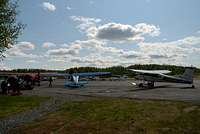



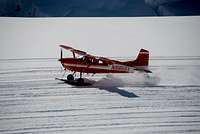


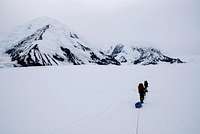
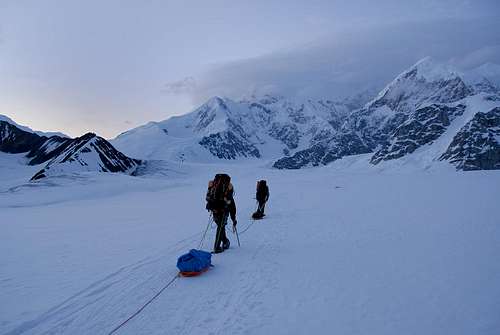

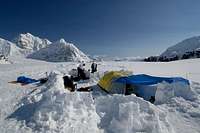



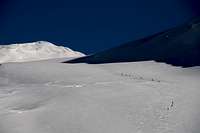








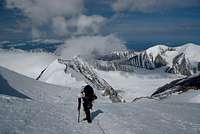


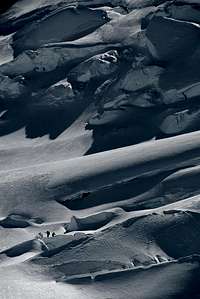



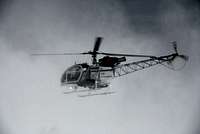




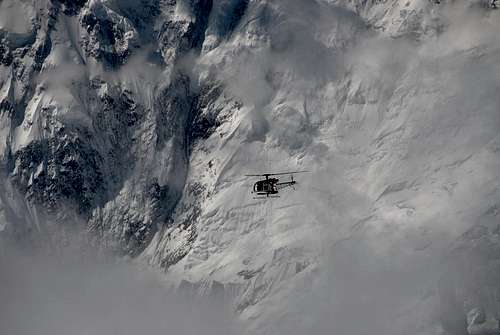









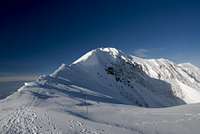
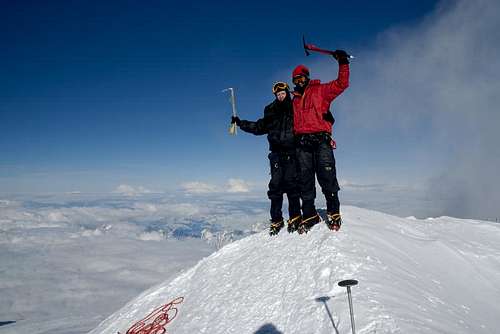


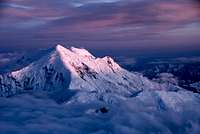



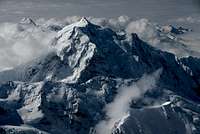
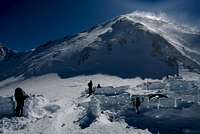

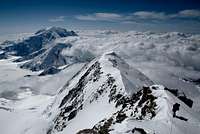
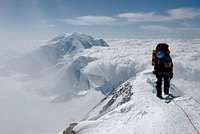
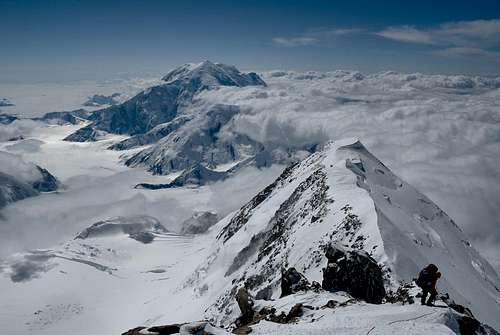


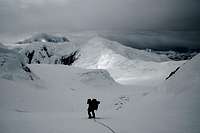
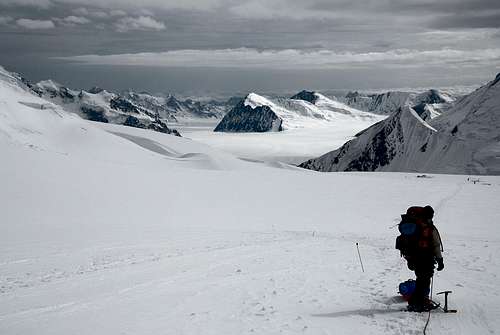

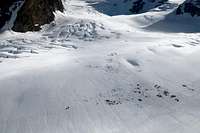
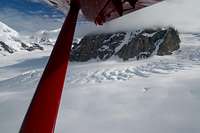


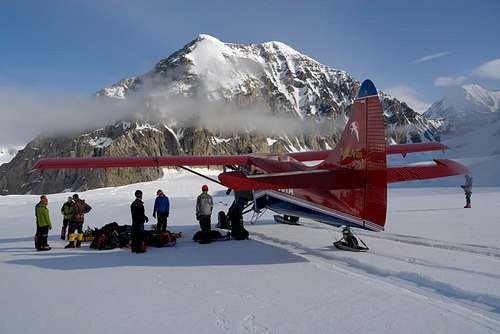
















Comments
Post a Comment